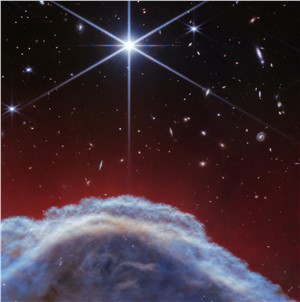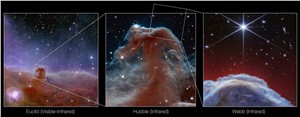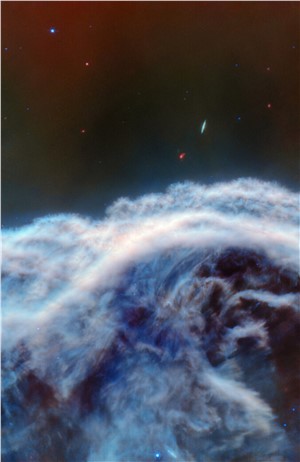


The NASA/ESA/CSA James Webb Space Telescope has captured the sharpest infrared images to date of one of the most distinctive objects in our skies, the Horsehead Nebula. These observations show a part of the iconic nebula in a whole new light, capturing its complexity with unprecedented spatial resolution.
Webb’s new images show part of the sky in the constellation Orion (The Hunter), in the western side of the Orion B molecular cloud. Rising from turbulent waves of dust and gas is the Horsehead Nebula, otherwise known as Barnard 33, which resides roughly 1300 light-years away.
The nebula formed from a collapsing interstellar cloud of material, and glows because it is illuminated by a nearby hot star. The gas clouds surrounding the Horsehead have already dissipated, but the jutting pillar is made of thick clumps of material that is harder to erode. Astronomers estimate that the Horsehead has about five million years left before it too disintegrates. Webb’s new view focuses on the illuminated edge of the top of the nebula’s distinctive dust and gas structure.

By Orbit Type (LEO, MEO, GEO, Others), by Architecture (Transparent Payload, Regenerative Payload), by Service Type (Fixed Satellite Service, Mobile Satellite Service, Broadband Satellite Service, Others), by End-User (Telecommunication, Government, Defense, Aviation, Others) and Region, with Forecasts from 2025 to 2034
Download free sample pages
-Zoom into the Horsehead Nebula
The Horsehead Nebula is a well-known photon-dominated region, or PDR. In such a region ultraviolet light from young, massive stars creates a mostly neutral, warm area of gas and dust between the fully ionised gas surrounding the massive stars and the clouds in which they are born. This ultraviolet radiation strongly influences the gas chemistry of these regions and acts as the most important source of heat.
These regions occur where interstellar gas is dense enough to remain neutral, but not dense enough to prevent the penetration of far-ultraviolet light from massive stars. The light emitted from such PDRs provides a unique tool to study the physical and chemical processes that drive the evolution of interstellar matter in our galaxy, and throughout the Universe from the early era of vigorous star formation to the present day.
Owing to its proximity and its nearly edge-on geometry, the Horsehead Nebula is an ideal target for astronomers to study the physical structures of PDRs and the evolution of the chemical characteristics of the gas and dust within their respective environments, and the transition regions between them. It is considered one of the best objects in the sky to study how radiation interacts with interstellar matter.
Thanks to Webb’s MIRI and NIRCam instruments, an international team of astronomers have revealed for the first time the small-scale structures of the illuminated edge of the Horsehead. They have also detected a network of striated features extending perpendicular to the PDR front and containing dust particles and ionised gas entrained in the photo-evaporative flow of the nebula. The observations have also allowed astronomers to investigate the effects of dust attenuation and emission, and to better understand the multidimensional shape of the nebula.
Next, astronomers intend to study the spectroscopic data that have been obtained of the nebula to evidence the evolution of the physical and chemical properties of the material observed across the nebula.
These observations were taken in the Webb GTO programme #1192 (PI: K. Misselt) and the results have been accepted for publication in Astronomy & Astrophysics (Abergel et al. 2024).